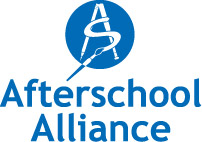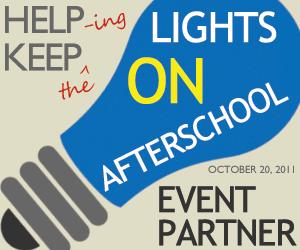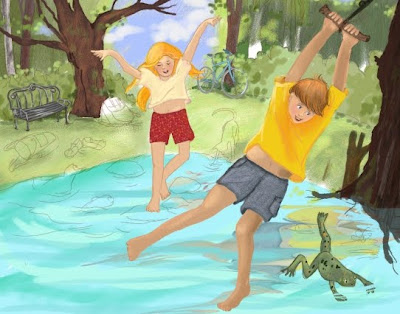At many public library locations, the after school rush means an influx of teens that happens with clockwork precision and presents unique opportunities as well as challenges.
Teen services staff may smile when 45 teens (who have been cooped up for eight hours in school listening to adults talk at them….) burst into the library. But, if librarians and library workers start acting like security guards and security guards start acting like bouncers… bad things can happen. The after school atmosphere can become rule-driven and the focus may shift to customer control instead of customer service. And while certainly there are situations that warrant “control” and “rules” – staff should primarily be concerned with making the after school library experience of teens a positive one. Anyone needing help with managing teen behavior can check out multiple resources from YALSA found on the wiki.
The after school rush is not a surprise. Ideally, there are positive patterns and routines established with library staff: these positive routines mean that during the after school rush staff does not disappear for off-desk time, break or dinner and teen activities take place. Staff is welcoming and not sending the vibe that they are bracing for an onslaught.
Learn the rush.
A library, like a retail location, experiences discernible traffic patterns of customer visits. Teen services staff should be observant and become aware of the teen traffic patterns after school at the library. First, is there an after school rush? Are there days of the week when teen traffic is heaviest? If there is an after school rush, when does it begin and when does it die down? Do teens tend to get picked-up when parents get out of work? Or leave to get home for dinner? Or linger until the library closes?
Scheduling programming/activities during the after school rush can seem daunting. Be vigilant about the excuse: “(I/we/you) can’t do a teen activity after school because there are too many teens in the library.” The after school rush may be the best time to begin offering activities—because teens are already there. Talk to them to find out why they're there and what activities may interest them or support their needs.
Know what time school dismissal occurs and talk to your manager about how this is not the time to schedule off desk time and dinner breaks. Staffing and after school activities for teens should be scheduled to meet the needs of customers (teens) not the convenience of the staff. Think of it in retail terms: shops schedule more staff during peak shopping hours to provide adequate customer service – (and because they want to make sales) - libraries can’t afford to be any different.
Use the rush.
If you are a teen services librarian or library worker at a public library, chances are at one time or another you’ve envied high school librarians their “captive audience” of teen students. Real or imagined, library staff working with teens at public libraries may perceive that high school librarians have easier access to teens interested in participating in library programming and activities.
The phenomenon of the after school rush may be the closest public library staff get to the fabled “captive audience” of teens. Bearing in mind that teens that visit the public library are not mandated to engage in any activity they do not want to engage in…. but, by the sheer number of teens visiting the library during the after school rush, chances improve for teens to participate in (and even organize and implement) teen activities in the library. The after school rush presents unique opportunities for teens to take ownership of space and activities intended for themselves and their peers.
Exploit this influx of teens to help you build not only good teen program attendance numbers for your monthly statistical report – but to build teen leaders in your library. This is prime time to make connections with teens. Here are some examples that shouldn't be too daunting for beginners:
- Getting teens busy planning and helping with activities, right there on the spot (even if the activities are not on the calendar).
- Suggesting ways for teens to take ownership of their library space and foster teen participation (e.g. decorating the teens' space – even if it only consists of book shelves).
- Asking teens to choose which activity should take place tomorrow and to return and help with it.
Don’t compete, compliment.
In addition to knowing dismissal time, teen services librarians and staff need to know the extracurricular / sports schedule. If Wednesday nights mean football… don’t schedule a program at the library.
And speaking of sports, if your library has a budget for publicity, why not consider purchasing an advertisement in the local high school’s printed Football Program? Even if teens don’t read it, parents (stuck) on the bleachers will, and an advertisement about how the library offers teens volunteer service hours – or free homework help will not go unnoticed by parents.
Seek to make the library available as a venue for school sanctioned extracurricular activities. If the high school debate team or model U.N. needs a place to meet, be quick to offer the library as a community venue for this type of activity. This is a great way to meet teens that may not otherwise be library users and may be interested in volunteering/leading.
What if the library is a ghost town after school?
If there isn’t an after school rush, that does not mean the library is off the hook when it comes to serving teens – it means two possibilities are true: teens need to be invited to the library and/or the library needs to take the library to teens. Sometimes the mountain has to be moved. Don't know where the teens are? They could be engaged with other youth serving organizations in the community, and you can easily find those via this Map My Community tool. The solution may be finding a venue in the community to provide not simply information “outreach” about library locations and services – but the direct delivery of library service to teens in an off-site location.
Explore the idea of a pop-up library – not just in the traditional access-to-books sense but teen library programming/activities that happen in local teen-centric retail outlets or in parking lots of football games or high school cafeterias. Connections between teens and the library can be fostered in novel and unexpected locations.
The library must play an important role in the after school life of teens in the service community. A recent survey shows that the majority of teens are leaving high school feeling unprepared for college and careers. This is a great opportunity for libraries to increase their impact and address a critical need of teens. After school is about: meeting the needs of teens – not the needs of the library location; opportunities to schedule activities for teens at times that are convenient for them – not for the library; ensuring that the library is a place in the community that helps support out-of-school learning, participation and leadership opportunities for teens.
The after school rush is coming – it’s not a surprise. Learn it. Use it. Best of luck.
P.S. Check out YALSA's after school resources on the wiki for help and inspiration!







